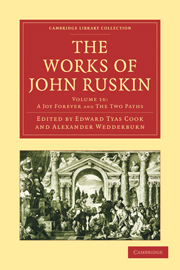Book contents
- Frontmatter
- Contents
- LIST OF ILLUSTRATIONS
- INTRODUCTION TO THIS VOLUME
- PART I “A JOY FOR EVER” BEING THE SUBSTANCE (WITH ADDITIONS) OF TWO LECTURES ON THE POLITICAL ECONOMY OF ART (1857, 1880)
- PART II INAUGURAL ADDRESS AT THE CAMBRIDGE SCHOOL OF ART (1858)
- BIBLIOGRAPHICAL NOTE
- TEXT OF ALL THE EDITIONS
- PART III THE OXFORD MUSEUM (1858, 1859)
- PART IV “THE TWO PATHS” (1859)
- APPENDIX: ADDRESSES AND LETTERS 1856–1860
- Plate section
TEXT OF ALL THE EDITIONS
Published online by Cambridge University Press: 07 September 2011
- Frontmatter
- Contents
- LIST OF ILLUSTRATIONS
- INTRODUCTION TO THIS VOLUME
- PART I “A JOY FOR EVER” BEING THE SUBSTANCE (WITH ADDITIONS) OF TWO LECTURES ON THE POLITICAL ECONOMY OF ART (1857, 1880)
- PART II INAUGURAL ADDRESS AT THE CAMBRIDGE SCHOOL OF ART (1858)
- BIBLIOGRAPHICAL NOTE
- TEXT OF ALL THE EDITIONS
- PART III THE OXFORD MUSEUM (1858, 1859)
- PART IV “THE TWO PATHS” (1859)
- APPENDIX: ADDRESSES AND LETTERS 1856–1860
- Plate section
Summary
1. I suppose the persons interested in establishing a School of Art for workmen may in the main be divided into two classes, namely, first, those who chiefly desire to make the men themselves happier, wiser, and better; and secondly, those who desire to enable them to produce better and more valuable work. These two objects may, of course, be kept both in view at the same time; nevertheless, there is a wide difference in the spirit with which we shall approach our task, according to the motive of these two which weighs most with us—a difference great enough to divide, as I have said, the promoters of any such scheme into two distinct classes; one philanthropic in the gist of its aim, and the other commercial in the gist of its aim; one desiring the workman to be better informed chiefly for his own sake, and the other chiefly that he may be enabled to produce for us commodities precious in themselves, and which shall successfully compete with those of other countries.
2. And this separation in motives must lead also to a distinction in the machinery of the work. The philanthropists address themselves, not to the artisan merely, but to the labourer in general, desiring in any possible way to refine the habits or increase the happiness of our whole working population, by giving them new recreations or new thoughts: and the principles of Art-education adopted in a school which has this wide but somewhat indeterminate aim, are, or should be, very different from those adopted in a school meant for the special instruction of the artisan in his own business.
- Type
- Chapter
- Information
- The Works of John Ruskin , pp. 177 - 202Publisher: Cambridge University PressPrint publication year: 2010First published in: 1905



